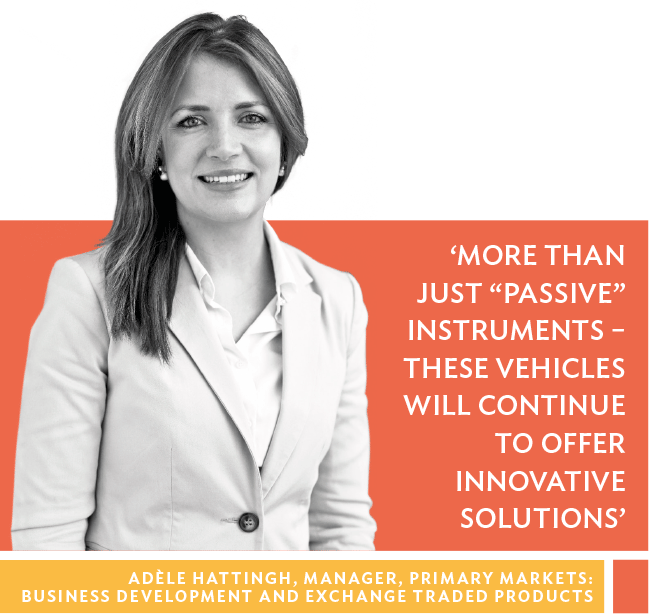The exchange traded funds (ETFs) and exchange traded products (ETPs) markets have swollen in size to more than $5 trillion globally. The debate about passive versus active management has long passed. ETFs have evolved from passive instruments that simply mirrored indices to ones that combine both passive and active investment strategies in a single instrument, via so-called smart beta overlay.
Adèle Hattingh, Primary Markets: Business Development and Exchange Traded Products Manager in the JSE’s Capital Markets division, says ‘it is possible, for example, for investors to invest in a single instrument whose underlying assets have been selected based on particular factors such as low volatility or momentum, rather than just their market capitalisation’.
Len Jordaan, head of distribution: ETFs at Absa, which is a large issuer of ETFs on the JSE, adds that ‘active and passive portfolios should perform very different functions in a portfolio, and it is up to investors to use both styles according to their needs. If used appropriately, the two styles are very complementary. The problem that we have in South Africa is that there are active funds that provide passive-like returns because they are constrained to very low tracking errors. This is changing though – much of the recent flows into active funds have been into smaller asset managers that have unconstrained mandates, with investors using passive funds for “market” exposure. This is the classic core-satellite strategy’.
According to Hattingh: ‘ETFs can help with strategic asset allocation or tactical asset allocation strategies, help equitise cash, and help manage a portfolio’s risk profile.’ She adds that ETFs are also able to offer a wide range of diversification options that are, most importantly, liquid. ‘Investors are able to access asset classes that are traditionally difficult to access through an easily accessible instrument [when] trading on the exchange. Examples of these include African – ex-SA – equity; precious metals such as rhodium, platinum or palladium, which don’t have to be held physically; offshore exposure such as global technology stocks; or global sovereign bonds.’
Investors could opt to integrate exposure into a portfolio by using a different asset class ETF. For example, a bond ETF could be added to a portfolio of single stocks. ‘Investors could also decide to “park” some of their excess cash through allocating their cash holdings to a particular ETF while they decide how and where to do their final allocation,’ says Hattingh. ‘Many institutional investors are using ETFs for exposure to other asset classes that they are not able to replicate in-house, such as commodity exposure.’
This has certain cost benefits, and this class of investor in particular will be cognisant of costs that affect returns. ‘The total expense ratios [TERs] of ETFs are decreasing, globally and locally, and with time, as institutional investors offer inflows into ETFs, scale will build and costs will decrease further,’ she says.
The TER is only one consideration. Because ETFs are bought and sold on the exchange, which allows for quick entry and exit from a position, liquidity risk is less of a concern, explains Hattingh. ‘Plus, with dedicated ETF market makers, it is possible to transact large transactions at the NAV [net asset value] price. In addition, because a secondary market exists for ETFs and units are freely available, primary market activity – creations and redemptions – only occurs when required, thus keeping operational costs low.’
Locally, adds Hattingh, ‘some institutional investors’ mandates often preclude the use of ETFs, but as awareness builds and investors understand the multiple uses of ETFs – that they are more than just “passive” instruments – these vehicles will continue to offer innovative solutions that are cost effective’.









